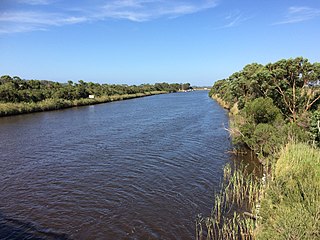
The Bemm River is a perennial river, located in the East Gippsland region of the Australian state of Victoria.
The Delegate River is a perennial river of the Snowy River catchment, located in the Alpine regions of the states of Victoria and New South Wales, Australia.
Genoa River is a perennial river located in the Monaro region of New South Wales and flows into the East Gippsland region of Victoria in Australia. It used to be known as Bondi Creek or Yard Creek. The river's name derives from the First People "jinoor" ("footpath").
The Yeerung River is a perennial river located in the East Gippsland region of the Australian state of Victoria.
The Little River is a perennial river of the Bemm River catchment, located in the East Gippsland region of the Australian state of Victoria.
The Mueller River is a perennial river with no defined major catchment, located in the East Gippsland region of the Australian state of Victoria.

The Brodribb River is a perennial river of the Snowy River catchment, located in the East Gippsland region of the Australian state of Victoria.

The Thurra River is a perennial river with no defined major catchment, located in the East Gippsland region of the Australian state of Victoria.

The Wingan River is a perennial river with no defined major catchment, located in the East Gippsland region of the Australian state of Victoria.
The Cann River East Branch is a perennial river located in the East Gippsland region of the Australian state of Victoria.
The Errinundra River is a perennial river of the Bemm River catchment, located in the East Gippsland region of the Australian state of Victoria.
The Combienbar River is a perennial river of the Bemm River catchment, located in the East Gippsland region of the Australian state of Victoria.
The Ada River is a perennial river of the Bemm River catchment, located in the East Gippsland region of the Australian state of Victoria.
The Goolengook River is a perennial river of the Bemm River catchment, located in the East Gippsland region of the Australian state of Victoria.
The Little Goolengook River is a perennial river of the Bemm River catchment, located in the East Gippsland region of the Australian state of Victoria.

The Arte River is a perennial river of the Bemm River catchment, located in the East Gippsland region of the Australian state of Victoria.
The Little Arte River is a perennial river of the Bemm River catchment, located in the East Gippsland region of the Australian state of Victoria.
The McKenzie River is a perennial river of the Bemm River catchment, located in the East Gippsland region of the Australian state of Victoria.
The Rich River is a perennial river of the Snowy River catchment, located in the East Gippsland region of the Australian state of Victoria.

The Berrima River, also called the Berrima Creek, is a perennial river of the Snowy River catchment, located in the Alpine region of the Australian states of New South Wales and Victoria.






